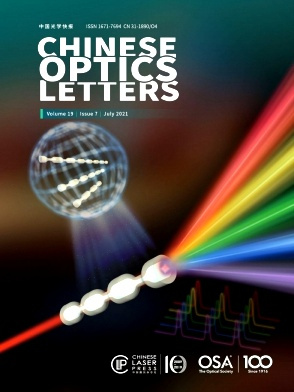
Journal of Systems Engineering and Electronics投稿地址
Journal of Systems Engineering and Electronics详细信息
Journal of Systems Engineering and Electronics
Journal of Systems Engineering and Electronics
Journal of Systems Engineering and Electronics投稿要求
Journal of Systems Engineering and Electronics杂志投稿须知:Aims and scopeThe journal, keeping abreast with the development trend of science and technology worldwide, reports the latest developments and achievements in systems engineering and electronics and related research areas, and encourages various academic views. The journal welcomes papers from a wide variety of countries.The journal strives to publish high-quality papers reporting original work in both theoretical and practical research results within the journal scope, involving system analysis, system modeling and simulation, military system analysis, aircraft control, C3I, radar, information systems engineering, machine intelligence, artificial neural networks, information acquisition and processing, aerospace electronics, and other topics in all related fields.TitleThe title is centered on the page and should be short and concise. Please limit the title to a maximum length of 10 words. The author’s name follows and is also centered on the page. The author’s last name should be preceded by the other names spelled out in full. The author’s affiliation and address are also needed.The corresponding author should be clearly indicated with the asterisk (i.e., *) and given on the bottom of the first page. Please provide the financial support acknowledgments (name and number) on the bottom of the first page.AbstractAn abstract, not exceeding 200 words, is required for all papers. Acronyms and abbreviations are spelled out at first mention in the abstract. It should be a summary of the paper and not an introduction. Because the abstract may be used in abstracting journals, it should present concisely the purposes, methodology used, results obtained, and conclusions.KeywordsThe author must provide a list of keywords, up to a maximum of six. No acronyms and abbreviations should be used.TextText should be typed in double-column. The introduction of paper should explain the nature of the problem, previous work, purpose, and contribution of the paper. It is assigned the number “1” and following sections are assigned number as needed. For example, the third section of a paper might be “3. Simulation results” headings. Acronyms and abbreviations are spelled out at first mention in the text, even they have already been defined in the abstract.Figures and tablesThe authors must ensure figures of sufficient quality and resolution. Figure captions appear below the figures. Figures should be numbered in the order they appear in the text. Table titles appear above the tables. Please verify that the figures and tables you mention in the text actually exist. When referring to a figure or a table in the text, use the abbreviation “Fig.” even at the beginning of a sentence, and do not abbreviate “Table”.EquationsNumber equations consecutively with equation numbers in parentheses flush with the right margin, as in (1). Be sure that the symbols in the equation have been defined before the equation appears or immediately following. When referring to “(1)”, do not use “Eq. (1)” or “equation (1),” except at the beginning of a sentence: “Equation (1) is ...”.ConclusionA conclusion must be included and should indicate clearly the advantages, limitations, and possible applications of the paper.AcknowledgmentIndividuals or units other than authors who were of direct help in the work should be acknowledged by a brief statement following the conclusion. This heading is not assigned a number.ReferencesOnly articles that have been published may be included in the references. Each reference is referred to in the text by a number enclosed in a square bracket (i.e., [3]). References must be numbered and ordered according to where they are first mentioned in the paper. A reference list must be included using the following information as a guide.BiographiesShort biographies (120-150 words) should be provided that detail the authors’ education, work histories and research interests as well as their E-mail. The authors’ full names are needed. Small (2.5 cm×3.5 cm), black-and-white and high- resolution (300 dpi) photos of each author should be included.
Journal of Systems Engineering and Electronics杂志简介
《Journal of Systems Engineering and Electronics》是《中国科学引文数据库》来源期刊,被美国科学引文索引(SCIE)、美国工程索引(EI)和英国科学文摘(SA)等多家国内、外著名检索系统收录。
《Journal of Systems Engineering and Electronics》是面向高科技开发和应用的跨学科期刊,以传播新技术、促进学术交流为宗旨,坚持深度与广度、理论与应用相结合的方针,努力反映系统工程与电子技术两大领域的最新成就,报道的主要内容包括:系统科学、军事系统分析、飞行器控制、雷达、光电探测技术、信息获取与处理、运筹学管理与决策技术等。
Journal of Systems Engineering and Electronics统计分析
影响因子:指该期刊近两年文献的平均被引用率,即该期刊前两年论文在评价当年每篇论文被引用的平均次数
被引半衰期:衡量期刊老化速度快慢的一种指标,指某一期刊论文在某年被引用的全部次数中,较新的一半被引论文刊载的时间跨度
他引率:期刊被他刊引用的次数占该刊总被引次数的比例用以测度某期刊学术交流的广度、专业面的宽窄以及学科的交叉程度
引用半衰期:指某种期刊在某年中所引用的全部参考文献中较新的一半是在最近多少年时段内刊载的
平均引文数:在给定的时间内,期刊篇均参考文献量,用以测度期刊的平均引文水平,考察期刊吸收信息的能力以及科学交流程度的高低
相关推荐
更多热门评论
Journal of Systems Engineering and Electronics杂志工作效率还是很高的,编辑相当认真负责,我论文中的参考文献并不是按照出现的先后顺序标注的,但是在出版稿中他帮我全部修改了。而且还包括了一部分笔误造成的语言错误。非常细致,推荐大家投这个杂志!
都说终审比较快,结果我又比较悲催,终审了半个月不见回复,按耐不住,发了个邮件询问编辑,编辑回复副主编可能是比较忙,耐心等待。结果发了邮件后三天,就收到了录用通知。真是惊喜。
期刊是不错的期刊,审稿很慢!回复也很慢!出刊也很慢,压个1半载很正常;投稿一个月后,收到改后再审,审了3个月没消息,发邮件石沉大海;等着毕业的通知慎重考虑。总体来说还是很不错的哦。
末投了一篇,三个月左右出结果,一个拒稿,一个小修,编辑让大修,一个月后返回,写了长长的反驳意见,二周左右接收,还是很意外加+惊喜的。
从投稿到正式录用大概2个月,6月份投稿的,8月20多号录用,投稿后一个月专家给了审稿意见,小修了一次,审稿速度算比较快的。这是我第一篇录用的文章,还是比较开心的。但是发稿还是比较慢的。
收稿后很快过了初审,交了审稿费就送外审了。两个审稿人,一个仅用了二十天左右的时候就返回了意见,另一个审了约一个半月,按要求认真修改以后,又过了一周左右,然后直接录用了。
在投稿网已经订了一杂志了,杂志质量很好,总体上还是很满意的。内容丰富,发货也还是比较及时的,也很正规,客服服务也还不错,物流也给力,到货及时,包装良好,值得信赖,加油。
同事介绍的这本杂志,周末时鼓起勇气投了一篇Journal of Systems Engineering and Electronics杂志,准备4个月给一审结果就不错了,投稿三天了一点反应没有,还是新到稿件,编辑真不知道忙什么呢,快点送审就好了,期盼能遇到好的审稿人~
挺好的一杂志,Journal of Systems Engineering and Electronics杂志编辑很耐心,修改意见也很中肯,是个值得投的期刊。见刊也很快呀,从投稿到见刊3个月。编辑真的很负责任,从审核到最后的发表,一直跟踪到底,而且态度很好。
Journal of Systems Engineering and Electronics杂志的文章要点很直接,很简要的。适合大学毕业做毕业论文的指导用书。现在大学生或研究生都不自己读书,而是要导师“告诉怎么做”,实际上,找几本指导书看看更明白。所以首推投稿网的书。
常见问题
| Q:论文发表的时候可以一稿多投吗? |
| A:一稿多投的行为是典型的学术不端的行为,是国内外学术界都明令禁止的行为,原因主要在于涉及到文章版权归属的问题,如果作者的文章已经被某个杂志社录用,或者同时被两家杂志社录用,就会涉及到版权纠纷,作为杂志社都会保护本社的合法权益,到这时作者就会比较麻烦,吃官司都是小事儿了,被打入黑名单降级降职影响可就太大了。 |
| Q:职称论文发表对时间有限制吗? |
| A:职称论文发表并没有明确规定截止时间,需要作者结合自己所在地区的具体规定自己安排发表时间,一般职称评审,各地区都会明确规定申报材料的最后期限和截止日期,我们结合这个日期来考虑何时发表文章就可以,大部分地区职称评审都集中在每年的8-10月之间,有的地区要求7月中旬开始交材料,最晚8月底之前,有的则是要求8月中旬交,还有部分地区要求截止时间为申报时间上年的12月31日,所以,各个地区的具体要求并不同,申报者需要在提交材料前确保自己的文章已经见刊并且被相应的数据库检索即可。 |
| Q:网上发表论文如何防骗?可靠网站与可疑网站如何区分? |
| A:由于发表论文的需求远远多于杂志版面的供应,再加上众所周知的审稿难!审稿慢!选择论文发表网站发表表论文确实能解决以上问题。卖方市场的出现加之发表论文的刚性需求,就导致出现先付款后发表的现状。论文发表网站正规与否是通过网站从始至终所提供服务体现出来的,任何交易只要存在时间差都会有风险,但这个风险是可以通过您的智慧来避免的。因为不是所有论文网站都是骗子,你要做的就是过滤掉没保障的网站,选择可靠的论文发表网站! |
| Q:一般期刊需要提前多久准备? |
| A:省级、国家级期刊建议至少提前6个月准备。一般来讲,杂志社为了确保每期杂志正常出刊,都会提前将当期之后1-3个月的稿件提前安排好,而一些创刊较早,认可度更高的热门期刊,来稿量较大,发表周期可能就会更久。提前准备,意味着杂志的可选择性更多。 |
| Q:核心期刊需要提前多久准备? |
| A:核心期刊建议至少提前12个月准备,核心期刊正常的审稿周期为1-3个月,且审核严格,退稿、返修几率更大,这意味着在流程上耗费的时间更久,且核心期刊版面有限,投稿竞争更加激烈,即使被录用,排刊也比普通期刊晚很多,因此需要更早准备。 |

